Heterocyclic compound
A heterocyclic compound or ring structure is a cyclic compound that has atoms of at least two different elements as members of its ring(s).[1] Heterocyclic chemistry is the branch of organic chemistry dealing with the synthesis, properties, and applications of these heterocycles.[2]


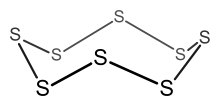
Examples of heterocyclic compounds include all of the nucleic acids, the majority of drugs, most biomass (cellulose and related materials), and many natural and synthetic dyes. 59% of US FDA-approved drugs contain nitrogen heterocycles.[3]
Classification
Although heterocyclic chemical compounds may be inorganic compounds or organic compounds, most contain at least one carbon. While atoms that are neither carbon nor hydrogen are normally referred to in organic chemistry as heteroatoms, this is usually in comparison to the all-carbon backbone. But this does not prevent a compound such as borazine (which has no carbon atoms) from being labelled "heterocyclic". IUPAC recommends the Hantzsch-Widman nomenclature for naming heterocyclic compounds.[4]
Heterocyclic compounds can be usefully classified based on their electronic structure. The saturated heterocycles behave like the acyclic derivatives. Thus, piperidine and tetrahydrofuran are conventional amines and ethers, with modified steric profiles. Therefore, the study of heterocyclic chemistry focuses especially on unsaturated derivatives, and the preponderance of work and applications involves unstrained 5- and 6-membered rings. Included are pyridine, thiophene, pyrrole, and furan. Another large class of heterocycles refers to those fused to benzene rings. For example, the fused benzene analogs of pyridine, thiophene, pyrrole, and furan are quinoline, benzothiophene, indole, and benzofuran, respectively. The fusion of two benzene rings gives rise to a third large family of compounds. Analogs of the previously mentioned heterocycles for this third family of compounds are acridine, dibenzothiophene, carbazole, and dibenzofuran, respectively. The unsaturated rings can be classified according to the participation of the heteroatom in the conjugated pi system.
3-membered rings
Heterocycles with three atoms in the ring are higher in energy and more reactive because of ring strain. Those containing one heteroatom are, in general, stable. Those with two heteroatoms are more likely to occur as reactive intermediates. The C-X-C bond angles (where X is a heteroatom) in oxiranes and aziridines are very close to 60° and the peripheral H-C-H bond angles are near to 180°.
Three-membered rings with one heteroatom
| Heteroatom | Saturated | Unsaturated |
|---|---|---|
| Boron | Borirane | Borirene |
| Nitrogen | Aziridine | Azirine |
| Oxygen | Oxirane (ethylene oxide, epoxides) | Oxirene |
| Phosphorus | Phosphirane | Phosphirene |
| Sulfur | Thiirane (episulfides) | Thiirene |
Three-membered rings with two heteroatoms
| Heteroatom | Saturated | Unsaturated |
|---|---|---|
| Nitrogen | Diaziridine | Diazirine |
| Nitrogen/oxygen | Oxaziridine | |
| Oxygen | Dioxirane |
4-membered rings
Four-membered rings with one heteroatom
| Heteroatom | Saturated | Unsaturated |
|---|---|---|
| Nitrogen | Azetidine | Azete |
| Oxygen | Oxetane | Oxete |
| Sulfur | Thietane | Thiete |
Four-membered rings with two heteroatoms
| Heteroatom | Saturated | Unsaturated |
|---|---|---|
| Nitrogen | Diazetidine | Diazete |
| Oxygen | Dioxetane | Dioxete |
| Sulfur | Dithietane | Dithiete |
5-membered rings
Five-membered rings with one heteroatom
| Heteroatom | Saturated | Unsaturated |
|---|---|---|
| Antimony | Stibolane | Stibole |
| Arsenic | Arsolane | Arsole |
| Bismuth | Bismolane | Bismole |
| Boron | Borolane | Borole |
| Nitrogen | Pyrrolidine ("Azolidine" is not used) | Pyrrole ("Azole" is not used) |
| Oxygen | Tetrahydrofuran | Furan |
| Phosphorus | Phospholane | Phosphole |
| Selenium | Selenolane | Selenophene |
| Silicon | Silacyclopentane | Silole |
| Sulfur | Tetrahydrothiophene | Thiophene |
| Tellurium | Tellurophene | |
| Tin | Stannolane | Stannole |
Five-membered rings with two heteroatoms
The 5-membered ring compounds containing two heteroatoms, at least one of which is nitrogen, are collectively called the azoles. Thiazoles and isothiazoles contain a sulfur and a nitrogen atom in the ring. Dithiolanes have two sulfur atoms.
| Heteroatom | Saturated | Unsaturated (and partially unsaturated) |
|---|---|---|
| Nitrogen/nitrogen | Imidazolidine Pyrazolidine |
Imidazole (Imidazoline) Pyrazole (Pyrazoline) |
| Nitrogen/oxygen | Oxazolidine Isoxazolidine |
Oxazole (Oxazoline) Isoxazole |
| Nitrogen/sulfur | Thiazolidine Isothiazolidine |
Thiazole (Thiazoline) Isothiazole |
| Oxygen/oxygen | Dioxolane | |
| Sulfur/sulfur | Dithiolane |
Five-membered rings with at least three heteroatoms
A large group of 5-membered ring compounds with three or more heteroatoms also exists. One example is the class of dithiazoles, which contain two sulfur atoms and one nitrogen atoms.
| Heteroatom | Saturated | Unsaturated |
|---|---|---|
| 3 × Nitrogen | Triazoles | |
| 2 × Nitrogen / 1 × oxygen | Furazan Oxadiazole | |
| 2 × Nitrogen / 1 × sulfur | Thiadiazole | |
| 1 × Nitrogen / 2 × oxygen | Dioxazole | |
| 1 × Nitrogen / 2 × sulfur | Dithiazole | |
| 4 × Nitrogen | Tetrazole | |
| 4 × Nitrogen/1 × Oxygen | Oxatetrazole | |
| 4 × Nitrogen/1 × Sulfur | Thiatetrazole | |
| 5 × Nitrogen | Pentazole |
6-membered rings
Six-membered rings with one heteroatom
| Heteroatom | Saturated | Unsaturated | Ions |
|---|---|---|---|
| Antimony | Stibinin[5] | ||
| Arsenic | Arsinane | Arsinine | |
| Bismuth | Bismin[6] | ||
| Boron | Borinane | Borinine | Boratabenzene anion |
| Germanium | Germinane | Germine | |
| Nitrogen | Piperidine (Azinane is not used) | Pyridine (Azine is not used) | Pyridinium cation |
| Oxygen | Tetrahydropyran | Pyran (2H-Oxine is not used) | Pyrylium cation |
| Phosphorus | Phosphinane | Phosphinine | |
| Selenium | Selenopyrylium cation | ||
| Silicon | Silinane | Siline | |
| Sulfur | Thiane | Thiopyran (2H-Thiine is not used) | Thiopyrylium cation |
| Tin | Stanninane | Stannine |
Six-membered rings with two heteroatoms
| Heteroatom | Saturated | Unsaturated |
|---|---|---|
| Nitrogen / nitrogen | Diazinane | Diazine |
| Oxygen / nitrogen | Morpholine | Oxazine |
| Sulfur / nitrogen | Thiomorpholine | Thiazine |
| Oxygen / oxygen | Dioxane | Dioxine |
| Sulfur / sulfur | Dithiane | Dithiin |
| Boron / nitrogen | 1,2-Dihydro-1,2-azaborine |
Six-membered rings with three heteroatoms
| Heteroatom | Saturated | Unsaturated |
|---|---|---|
| Nitrogen | Triazinane | Triazine |
| Oxygen | Trioxane | |
| Sulfur | Trithiane |
Six-membered rings with four heteroatoms
| Heteroatom | Saturated | Unsaturated |
|---|---|---|
| Nitrogen | Tetrazine |
Carborazine is a six-membered ring with two nitrogen heteroatoms and two boron heteroatom.
Six-membered rings with five heteroatoms
| Heteroatom | Saturated | Unsaturated |
|---|---|---|
| Nitrogen | Pentazine |
7-membered rings
With 7-membered rings, the heteroatom must be able to provide an empty pi orbital (e.g., boron) for "normal" aromatic stabilization to be available; otherwise, homoaromaticity may be possible. Compounds with one heteroatom include:
| Heteroatom | Saturated | Unsaturated |
|---|---|---|
| Boron | Borepin | |
| Nitrogen | Azepane | Azepine |
| Oxygen | Oxepane | Oxepine |
| Sulfur | Thiepane | Thiepine |
Those with two heteroatoms include:
| Heteroatom | Saturated | Unsaturated |
|---|---|---|
| Nitrogen | Diazepane | Diazepine |
| Nitrogen/sulfur | Thiazepine |
8-membered rings
| Heteroatom | Saturated | Unsaturated |
|---|---|---|
| Nitrogen | Azocane | Azocine |
| Oxygen | Oxocane | Oxocine |
| Sulfur | Thiocane | Thiocine |
Borazocine is an eight-membered ring with four nitrogen heteroatoms and four boron heteroatom.
9-membered rings
| Heteroatom | Saturated | Unsaturated |
|---|---|---|
| Nitrogen | Azonane | Azonine |
| Oxygen | Oxonane | Oxonine |
| Sulfur | Thionane | Thionine |
Images
- Names in italics are retained by IUPAC and they do not follow the Hantzsch-Widman nomenclature
| Saturated | Unsaturated | ||||||
|---|---|---|---|---|---|---|---|
| Heteroatom | Nitrogen | Oxygen | Sulfur | Nitrogen | Oxygen | Sulfur | |
| 3-Atom Ring | Aziridine | Oxirane | Thiirane | Azirine | Oxirene | Thiirene | |
 |  |  |  |  |  | ||
| 4-Atom Ring | Azetidine | Oxetane | Thietane | Azete | Oxete | Thiete | |
 |  |  |  |  |  | ||
| 5-Atom Ring | Pyrrolidine | Oxolane | Thiolane | Pyrrole | Furan | Thiophene | |
 |  |  |
 |  |  | ||
| 6-Atom Ring | Piperidine | Oxane | Thiane | Pyridine | Pyran | Thiopyran | |
 | .svg.png) |  |
 |  | 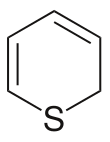 | ||
| 7-Atom Ring | Azepane | Oxepane | Thiepane | Azepine | Oxepine | Thiepine | |
 |  | 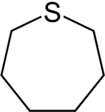 |  | 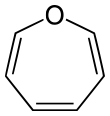 |  | ||
| 8-Atom Ring | Azocane | Oxocane | Thiocane | Azocine | Oxocine | Thiocine | |
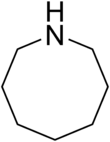 |  |  |  |  |  | ||
| 9-Atom Ring | Azonane | Oxonane | Thionane | Azonine | Oxonine | Thionine | |
 |  |  |  |  |  | ||
Fused rings
Heterocyclic rings systems that are formally derived by fusion with other rings, either carbocyclic or heterocyclic, have a variety of common and systematic names. For example, with the benzo-fused unsaturated nitrogen heterocycles, pyrrole provides indole or isoindole depending on the orientation. The pyridine analog is quinoline or isoquinoline. For azepine, benzazepine is the preferred name. Likewise, the compounds with two benzene rings fused to the central heterocycle are carbazole, acridine, and dibenzoazepine. Thienothiophene are the fusion of two thiophene rings. Phosphaphenalenes are a tricyclic phosphorus-containing heterocyclic system derived from the carbocycle phenalene.
History of heterocyclic chemistry
The history of heterocyclic chemistry began in the 1800s, in step with the development of organic chemistry. Some noteworthy developments:[7]
1818: Brugnatelli isolates alloxan from uric acid
1832: Dobereiner produces furfural (a furan) by treating starch with sulfuric acid
1834: Runge obtains pyrrole ("fiery oil") by dry distillation of bones
1906: Friedlander synthesizes indigo dye, allowing synthetic chemistry to displace a large agricultural industry
1936: Treibs isolates chlorophyl derivatives from crude oil, explaining the biological origin of petroleum.
1951: Chargaff's rules are described, highlighting the role of heterocyclic compounds (purines and pyrimidines) in the genetic code.
Uses
Heterocyclic compounds are pervasive in many areas of life sciences and technology.[2] Many drugs are heterocyclic compounds.[8]
References
- IUPAC Gold Book heterocyclic compounds
- Thomas L. Gilchrist "Heterocyclic Chemistry" 3rd ed. Addison Wesley: Essex, England, 1997. 414 pp. ISBN 0-582-27843-0.
- Edon Vitaku, David T. Smith, Jon T. Njardarson (2014). "Analysis of the Structural Diversity, Substitution Patterns, and Frequency of Nitrogen Heterocycles among U.S. FDA Approved Pharmaceuticals". J. Med. Chem. 57: 10257-10274. doi:10.1021/jm501100b. PMID 25255204.CS1 maint: multiple names: authors list (link)
- IUPAC, Compendium of Chemical Terminology, 2nd ed. (the "Gold Book") (1997). Online corrected version: (2006–) "Hantzsch–Widman name". doi:10.1351/goldbook.H02737
- "Stibinin". chemspider. Royal Society of Chemistry. Retrieved 11 June 2018.
- "Bismin". ChemSpider. Royal Society of Chemistry. Retrieved 11 June 2018.
- Campaigne, E. (1986). "Adrien Albert and the rationalization of heterocyclic chemistry". Journal of Chemical Education. 63 (10): 860. doi:10.1021/ed063p860.
- "IPEXL.com Multilingual Patent Search, Patent Ranking". www.ipexl.com.
External links
| Wikimedia Commons has media related to heterocyclic compounds. |
| Wikiquote has quotations related to: Heterocyclic compound |